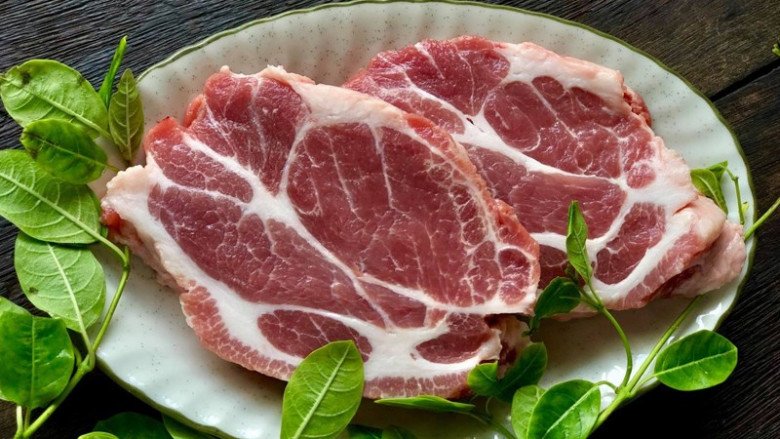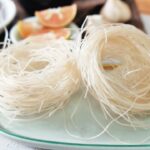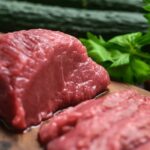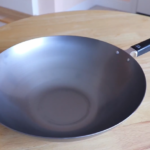Pork Front Trotters
A pig has four trotters in total, with two front and two hind trotters. However, the front trotters are more active, resulting in more tendons. This means the meat is thinner and leaner but has a more delicate flavor, a cleaner taste, and a slight crunch. This cut is suitable for boiling, stewing, or preparing dishes like ‘chao’, ‘gia cay’, or pork congee.

Three-Layer Pork Belly
Three-layer pork belly, with its alternating layers of lean meat and fat, is a familiar cut. Previously, many people thought that this cut was too fatty and, therefore, not tasty, but it has since become a popular choice due to its tender and non-greasy nature.
When selecting three-layer pork belly, it’s important to distinguish between the upper and lower sections. The upper portion, located outside the rib cage, has more fat and less lean meat. Its fat is not as soft, and the meat is firmer, with fewer layers, usually only three. The structure of this cut is generally less compact, with the fat and lean not as closely intertwined.

This upper portion is not ideal for dishes like braising, grilling, or stir-frying, as it can be too greasy. Instead, it’s best used as minced meat for fillings in dishes like fried spring rolls (‘nem ran’), steamed buns (‘banh bao’), ‘cha la lot’, or ‘xiu mai’, resulting in a delicious, soft, and aromatic treat.
The lower belly section, on the other hand, is the abdominal muscle and the latter half of the pig’s belly. This cut typically has five distinct layers of fat and lean, with each layer evenly distributed, creating a refined texture that doesn’t feel greasy when eaten. Some exceptional pieces may even have seven layers of fat and lean.
The lower belly section is superior in flavor and appearance to the upper portion. As a result, it shines in any dish, whether grilled, braised, stir-fried, stewed, or roasted. Dishes made with this cut are tasty, fragrant, and fatty without being overwhelming.
Pork Loin
Pork loin is a muscle located inside the spine and is rarely used, resulting in exceptionally tender meat with almost no fat. It has a unique sweetness and aroma, and each pig only has two of these long, thin loins. This cut is delicious whether boiled or stir-fried.
Pork Shoulder
The pork shoulder, or upper part of the pig’s front leg, has a cross-section that is 90% lean, with thin layers of fat in between, forming a floral pattern. The meat is both slightly crunchy and tender, especially at the top of the shoulder, with a sweet and fragrant taste that isn’t greasy.

This cut is delicious when stir-fried, grilled, braised, or boiled. So, the next time you’re at the market, be sure to pick up some pork shoulder for your family meals.
The Secret to Crispy, Aromatic, and Cohesive Stir-Fried Pork for Tet: Master These 5 Tips!
This is a must-have dish for the Lunar New Year feast, and many are intrigued by its delicious flavor. To successfully prepare this dish, one must possess certain tricks up their sleeve. It is a delicacy that requires a special touch, and with the right techniques, one can create a mouth-watering treat that will leave guests wanting more.
“Pork Rinse: A Clean and Tasty Transformation”
Introducing: The Ultimate Guide to Safe Pork Handling and Preparation.
You’ve probably heard the age-old advice to always wash your pork before cooking it. But did you know that this common practice could actually be doing more harm than good? It’s time to unravel the truth and discover the right way to handle and prepare pork.
Stay tuned for a comprehensive guide that will transform the way you think about pork preparation. From understanding the risks associated with improper handling to mastering the art of safe and delicious cooking, we’ll cover everything you need to know to become a pork-prep pro.






































